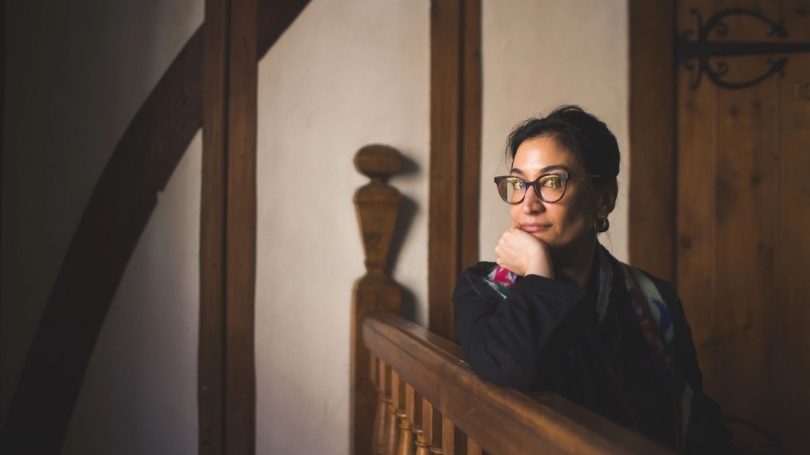
Menu
- About
- Departments & Programs
- Faculty Resources
- Governance
- Diversity
- News
Back to Top Nav
Back to Top Nav
Back to Top Nav
Back to Top Nav
Professor Nirvana Tanoukhi created the first college course on the rise of meme culture and will co-lead a public conference at Dartmouth on Feb. 23 and 24 that centers the impact of memes on politics and society.
Why should scholars take memes seriously? Why does the public engage with them, and how? Are they positive or negative forces in our increasingly digital society? Or do they transcend such reductive labels?
These and other probing questions will be posed at a public conference at Dartmouth called Memetics and Mimesis: The Memosphere in the Public Sphere. Part of the four-part public humanities project VPM, Engaging Memes, the multifaceted event on Feb. 23 and 24 will bring together scholars from the humanities and humanistic social sciences who are "trying to think about this new cultural form across generations and the political spectrum," says Assistant Professor of English and Creative Writing Nirvana Tanoukhi, who with professor Liam Kruger of the University of Notre Dame co-organized the conference.
The conference keynote speakers are Ryan Milner, associate professor of communications at the College of Charleston, who examines how online interaction matters socially, politically, and culturally, and Nan Z. Da, associate professor of English at Johns Hopkins University, whose research interests include literary and social theory and the intersection of literary studies with data sciences. Milner is the author of The World Made Meme, Public Conversations and Participatory Media.
Running parallel to the conference will be a public exhibit curated by students in Tanoukhi's first-year seminar on memes, with the support of the Design Initiative at Dartmouth, displaying artifacts intended to capture the spirit of meme culture.
The seminar is the first college course to focus on the rise of meme culture, with its special aesthetic forms and dynamics of communication.
Merriam-Webster updated its definition of meme in 2015 with an emphasis on digital culture as "an amusing or interesting item (such as a captioned picture or video) or genre of items that is spread widely online, especially through social media."
Tanoukhi's own interest in meme culture stems from a broader understanding of the way shared conversation in the public sphere has shifted over centuries.
"According to political theorists and cultural historians, the emergence of narrative fiction in the late 17th century was essential to the rise of the public sphere," she says. "Literature, and specifically narrative fiction, is credited for modeling what we call 'open' conversation. But literature has ceased to be that kind of object, and literary culture has ceased to be such a space. Similar to discourse in the political sphere, public conversations about literature and art tend to end before they begin. And this difficulty, what it says about us, is starker in literary culture, where discussing and disagreeing is supposed to be easier, because it is relatively low-stakes."
On the other hand, she posits, memes, especially among young adults who are highly engaged with memetic forms and media, generate lively public discourse.
"This project asks: 'What about memetic forms keeps parties in conversation in the room?' says Tanoukhi. "As a literary critic, I am interested in how new memetic forms bring out that democratic civility we need to live with others in pluralistic societies—that ability to argue and laugh together spontaneously, without referees, formal structures, or the like. This is the ability which some think we have irretrievably lost, and others claim we never really had."
One of the VPM student research groups will suggest in their talk at the conference that it has to do, in part, with the function of authorship in meme culture.
"People can talk about memes, they can share memes, they can laugh together about them without the usual traps that come up when you start a conversation about a novel, a play, or a painting," Tanoukhi says. "So, for example, race is not a deterrent. It's not something you necessarily trip on when you're in the memosphere. It doesn't necessarily have to get in the way. And nobody stops the conversation by saying, 'who are you to laugh?'"
Tanoukhi says many of her students arrive on campus already adept at meme making and sharing, and with a broad and deep historical and formal knowledge of memetic culture and its forms at their disposal, ready to write and talk about the digital realm in ways that enlighten not only each other, but their professors.
"We often think of a meme as a small frame, an image with a caption, but actually a meme is anything that is shared online, and every time you share it, you may change it. It can be a video; it can be an object that you buy through TikTok, and then do something to it. So it's hyper-participatory," says Tanoukhi.
Alyssa Noseworthy '24, who has been a teaching assistant in Tanouhki's seminar, a researcher for the memetics working group, and a student coordinator for the public humanities project, is eager to exchange ideas with other navigators of the burgeoning memosphere.
"Part of that is trying to show memes as worthy of being openly examined in academia, because there are not a lot of people writing about what young users do and like about engaging memes yet," she says. "And those who do are mostly interested in memes from a political perspective—whether or not they're going to help win elections. But what we're doing here is looking beyond short-term political outcomes, at the use of memes through cultural and literary theory."